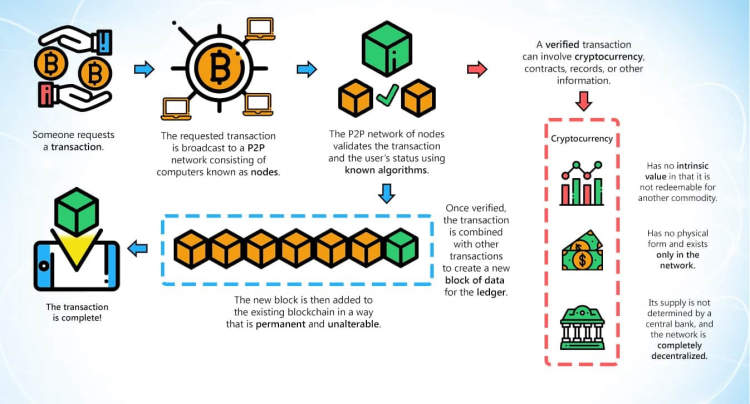Blockchain technology is revolutionizing various industries, from finance to supply chain management. But what exactly is blockchain and how does it work?
At its core, blockchain is a distributed ledger that records transactions across multiple computers in a transparent and secure manner. Each transaction, or block, is connected to the previous one, forming a chain of information that cannot be altered or manipulated easily. This decentralized system eliminates the need for intermediaries, allowing for trustless and efficient transactions. In this article, we will delve deeper into the workings of blockchain technology and explore its potential impact on different sectors.
Introduction to Blockchain Technology
In recent years, blockchain technology has gained significant attention as a revolutionary concept with the potential to transform various industries. Essentially, blockchain is a decentralized digital ledger that securely records and verifies transactions across multiple computers, making it virtually impossible to tamper with or hack. This technology introduces transparency, trust, and efficiency, eliminating the need for intermediaries and providing a new way to carry out transactions.
Blockchain relies on a network of computers called nodes, which work together to validate transactions and add them to a shared, immutable ledger known as the blockchain. Each transaction is grouped into a block, and once verified, it is added to the chain in a chronological order. This chain of blocks creates a permanent and transparent record of all transactions, making it easy to track and audit.
Key Features of Blockchain Technology
- Decentralization: Unlike traditional systems, blockchain operates on a peer-to-peer network without a central authority. This decentralization ensures that no single entity has control over the entire system, promoting fairness and preventing manipulation.
- Immutability: Once a transaction is recorded on the blockchain, it becomes permanent and cannot be altered or erased. This immutability adds security and trust to the system, as it becomes challenging to manipulate or falsify data.
- Security: Blockchain technology uses advanced cryptographic techniques to secure transactions. Each block contains a unique cryptographic hash, which links it to the previous block, forming a chain. Changing information in one block would require altering all subsequent blocks, making it extremely difficult for hackers to tamper with the data.
- Transparency: All transactions recorded on the blockchain are visible to all participants in the network. This transparency increases accountability and trust among users, as they can verify and track each transaction in real-time.
- Efficiency and Cost-Saving: By eliminating the need for intermediaries, blockchain technology streamlines transactions, reducing the time and costs associated with traditional processes. The automated nature of blockchain also eliminates human errors and enhances overall efficiency.
Blockchain technology has shown immense potential beyond cryptocurrencies like Bitcoin. It has the ability to revolutionize various sectors, including finance, supply chain management, healthcare, voting systems, and more. As this technology continues to evolve, it is crucial to understand its fundamental concepts and how it can reshape the future.
Understanding the Basics of Blockchain

In recent years, blockchain technology has gained immense popularity and is revolutionizing various industries. Whether you are a technology enthusiast or just an average user, it is essential to grasp the basics of this transformative technology.
Here are some key points to help you understand the fundamental concepts of blockchain:
What is Blockchain?
Blockchain is a decentralized and transparent digital ledger that records transactions across multiple computers or nodes. It is designed to be secure, tamper-resistant, and resistant to censorship. Each transaction is stored in a “block” and linked to previous transactions, forming a chronological chain.
How Does Blockchain Work?
Blockchain operates on the principle of consensus and cryptography. When a transaction is initiated, it is broadcasted to a network of computers known as nodes. These nodes verify the transaction and reach a consensus on its validity. Once approved, the transaction is added to a block and added to the chain, making it immutable.
Some key features of blockchain technology include:
- Decentralization: No single authority or entity controls the blockchain, making it more resilient to attacks and failures.
- Transparency: All transactions are recorded and visible to anyone on the network, contributing to trust and accountability.
- Security: Blockchain uses cryptographic techniques to secure transactions and prevent unauthorized tampering.
- Smart Contracts: Blockchain can also support programmable self-executing contracts, known as smart contracts, which automate processes without the need for intermediaries.
Applications and Benefits of Blockchain
Blockchain technology has applications beyond cryptocurrency. Some of its potential uses include:
- Supply Chain Management: Blockchain can increase transparency and traceability in supply chains, reducing fraud and improving efficiency.
- Financial Services: Blockchain enables faster, secure, and cost-effective cross-border transactions, as well as enables financial inclusion for the unbanked population.
- Healthcare: Blockchain can streamline medical record management, ensure the privacy and security of patient data, and facilitate interoperability between different healthcare providers.
- Voting Systems: Blockchain offers a transparent and tamper-resistant solution for voting, enhancing democracy and reducing electoral fraud.
As blockchain technology continues to evolve, it has the potential to transform various industries and disrupt traditional systems. By understanding the basics of blockchain, you can stay informed and explore the exciting possibilities it offers.
Conclusion
In conclusion, blockchain technology is a groundbreaking innovation that has the potential to revolutionize various industries. It is a decentralized, transparent, and secure system that enables the secure transfer and recording of digital transactions. By eliminating the need for intermediaries, blockchain technology reduces costs, increases efficiency, and enhances trust in transactions.
Additionally, blockchain technology has the potential to disrupt industries beyond finance. It can be utilized in healthcare to improve data security and interoperability, in supply chain management to enhance traceability and transparency, and even in voting systems to ensure fair and tamper-proof elections. As more industries recognize the benefits of blockchain technology, its adoption is expected to soar in the coming years, ushering in a new era of decentralization and innovation.

0 Komentar untuk "What Is Blockchain Technology and How Does It Work?"